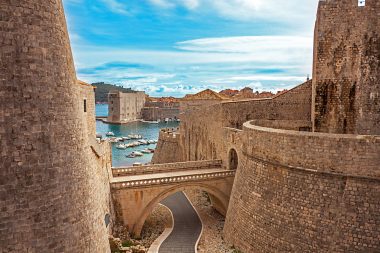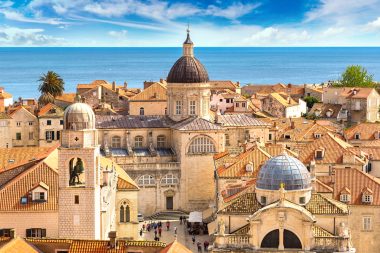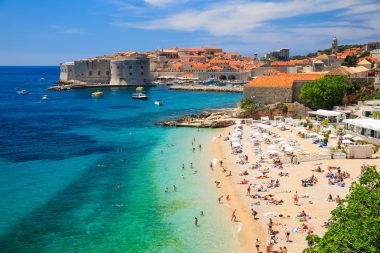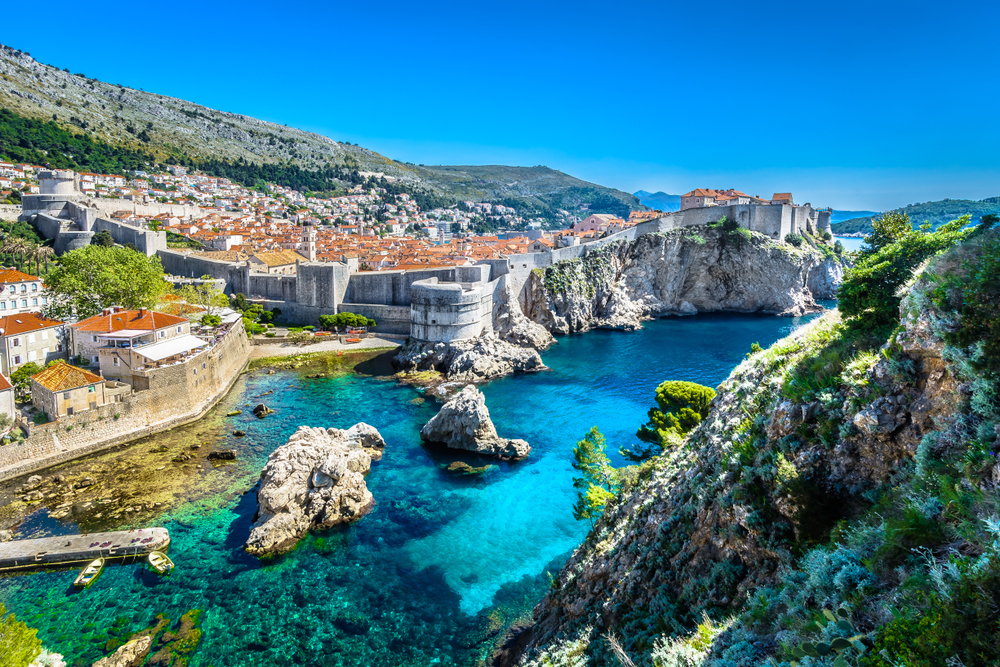As early as the 19th century, nobles from imperial Vienna enjoyed the mild climate on the Adriatic Sea in Croatia. In Dubrovnik today, visitors can expect: medieval squares, magnificent churches and numerous museums. The highlight of Dubrovnik is a walk on the world-famous city walls, with a view of the azure blue sea and the rooftops of the city.
The sights of Dubrovnik

Dubrovnik is a large open-air stage: in 1980, UNESCO declared large parts of the old town a World Heritage Site. Justly! Magnificent monuments and churches line up next to museums, small cafés and restaurants – enclosed by the city wall. Dubrovnik was founded in the 7th century. The diplomatic skills of the inhabitants made the city more and more influential over the centuries.
The salt trade was a lucrative source of income at that time! In 1667, the economy suddenly came to a standstill: a violent earthquake caused severe damage to the city. It was only through the construction of the railway line that tourism in the city was able to develop. So it finally went up again! During a guided tour of the city, travelers learn more about the history. Guided tours can be booked at the municipal tourist information.
The best view of Dubrovnik, the harbor and the sea is from the city walls. There are several entrances. The circular trail is two kilometers long and runs at a height of 25 meters. If you prefer it more comfortable, you should explore the city on an open-top double-decker bus. The tour takes visitors from the old town to the Lapad peninsula and back. If you want to go even higher, you should take the cable car to the local mountain. On the summit stands an impressive Napoleon fortress. It now houses a museum that reports on the effects of the war.
Art & Culture

In Dubrovnik, you can walk in the footsteps of the Romans, Habsburgs and Venetians. Many squares in the old town are of medieval origin. There are numerous churches, cathedrals and monasteries. The visit to the Dominican monastery is impressive.
It was built at the beginning of the 13th century and today houses an important art collection, with paintings by Croatian and Italian masters from the 15. and 16th century. The Franciscan monastery with church is also well worth seeing. The monastery was built in the 14th century. Even the architecture inspires from the outside. The building was designed in a quadrangle with a cloister. The monastery is home to the Franciscan Pharmacy – one of the oldest pharmacies in Europe. Next to the main staircase to the city wall is the town church of Sv. Spas.
The interior of the church is adorned with magnificent altarpieces. Also located in the city center of Dubrovnik – Zudioska ulica – the second oldest synagogue in Europe. In the fortress Sv. Ivan is an aquarium – a popular destination for children. Next door, the city’s maritime history can be explored. The Sponza Palace from 1506 survived the severe earthquake of the city. Visitors can still marvel at the famous stonemasonry work of Master Andrijic.
The cathedral church of Velika Gospa fared differently: it was completely destroyed during the tragic earthquake in 1667. The new building was built in the 18th century. In the treasury there are paintings by Titian and Raphael. Guests should definitely combine a visit to the Lovrjenac Fortress, which was built as early as 1050, with a visit to the summer festival. An incomparable setting!
Special Events

Every year on 3 February, the town festival Sv. Vlaha in Dubrovnik. Many locals, including those from nearby villages, take part in the large procession. They wear old Croatian costumes on this special holiday. A special sight! But even in the summer months there is always something going on in the old town of Dubrovnik. Many events take place such as folklore performances, sailing regattas or concerts with international artists.
The climate in Dubrovnik
Dubrovnik has a Mediterranean climate. The summer is steady, the winter rather mild. Culture-loving visitors who want to explore Dubrovnik’s sights can enjoy the warm spring weather in the city as early as April. In midsummer, the heat accumulates in the narrow streets of the old town. Then is the best time for a trip to the beach. Bathing enthusiasts and water sports enthusiasts will now get their money’s worth. The Adriatic Sea is heated up until autumn. The best conditions for a varied holiday.
Croatian specialties
Visitors who want to discover the city’s culinary delights will find a wide range of dishes. Sun-ripened fruit and vegetables, freshly caught fish, aromatic spices and fresh, pressed olive oil. The country has a long food culture! The Balkans have left their mark on Dubrovnik. Meat rolls with ajvar and Djuvec rice are still very popular.
Another speciality is pork goulash with peppers and tomatoes. Of course, there is a large selection of fish – preferably grilled. Aromatic wines produced around Dubrovnik are served with the meal. One of the most famous winemakers in Croatia is Elido Pilato. His wines can be found on many menus of good restaurants and some delicatessens in the city. Popular desserts are strudel with quark and apples or pancakes with a delicious chocolate sauce.
People like to drink an espresso or the country’s liqueur specialties – Julishka and Slivovitz – with it. By the way, olive oil, liqueur and wine are popular souvenirs for those who stayed at home!
Day trips
20 kilometres north of Dubrovnik is the coastal town of Tresteno. Visitors should visit the 2.8-hectare “Arboretum” park. Exotic plants from all over the world grow here. The park was built in the 16th century by the Croatian Gucetic-Gozze family. The park once belonged to a magnificent summer residence, but it was completely destroyed in the earthquake of 1667. The archipelago “Elaphite Archipelago” is also worth seeing. There are secluded bays with fine sandy beaches.
Museums
Dubrovnik, also known as the “Pearl of the Adriatic”, offers a rich history and culture. Here are some of the must-see museums to visit during your stay:
- Rector’s Palace: This historic building is home to the Dubrovnik Museum of Cultural History, which displays a variety of exhibits from the city’s rich history. Address: Pred Dvorom 1, 20000 Dubrovnik.
- Franciscan Monastery and Museum: A 14th-century monastery with one of the oldest pharmacies in Europe and an impressive library. Address: Stradun, 20000 Dubrovnik.
- Dubrovnik City Museum: This museum is located in the Sponza Palace and displays exhibits on the history and culture of the city. Address: Stradun 2, 20000 Dubrovnik.
- War Photo Limited: A photography museum focused on documenting war and conflict, with a special collection about the Croatian War. Address: Antuninska 6, 20000 Dubrovnik.
- Maritime Museum: Located in Fort St. John, this museum showcases Dubrovnik’s maritime history. Address: Kneza Damjana Jude 12, 20000 Dubrovnik.
Restaurants
Dubrovnik offers a variety of restaurants serving local and international cuisine. Here are some of the best restaurants in town:
- Proto: An upscale restaurant known for its fish and seafood dishes, right in the old town. Address: Široka ulica 1, 20000 Dubrovnik.
- Nautika: An elegant restaurant with breathtaking views of the city walls and the sea, offering a mix of Dalmatian and Mediterranean cuisine. Address: Brsalje 3, 20000 Dubrovnik.
- 360 Degrees: A Michelin-starred restaurant that offers innovative dishes in a historic setting, with a terrace that offers spectacular views of the Old Port. Address: Sv. Dominika bb, 20000 Dubrovnik.
- Kopun: A charming restaurant serving traditional Croatian dishes with modern twists. Address: Poljana Ruđera Boškovića 7, 20000 Dubrovnik.
- Restaurant Dubrovnik: A restaurant in the old town known for its excellent Dalmatian cuisine and romantic atmosphere. Address: Marojice Kaboge 5, 20000 Dubrovnik.
Well-known hotels
Dubrovnik offers a variety of accommodation options, from luxurious hotels to cozy boutique hotels:
- Hotel Excelsior Dubrovnik: A luxury hotel on the seafront, within walking distance of the Old Town, known for its first-class service and breathtaking views. Address: Frana Supila 12, 20000 Dubrovnik.
- Villa Dubrovnik: An exclusive boutique hotel with private access to the sea and luxurious amenities. Address: Vlaha Bukovca 6, 20000 Dubrovnik.
- Hotel Bellevue Dubrovnik: A modern five-star hotel perched on a cliff with spectacular sea views and a private beach. Address: Pera Čingrije 7, 20000 Dubrovnik.
- Hilton Imperial Dubrovnik: A historic hotel that offers modern comfort and elegance, just a few steps from the Old Town. Address: Marijana Blažića 2, 20000 Dubrovnik.
- Pucić Palace: A boutique hotel located in a historic 18th-century palace in the heart of the Old Town. Address: Ul. Od Puča 1, 20000 Dubrovnik.
How to get there
Dubrovnik is well connected to the transport network and easily accessible:
- Plane:
- Dubrovnik Airport (DBV): The main airport in the region, about 20 km southeast of Dubrovnik. Regular bus and taxi services take travelers to the city center.
- Ship:
- Ferry connections: Regular ferries connect Dubrovnik with other cities along the Adriatic coast as well as with Italy.
- Car:
- Good road connections from neighboring countries and within Croatia, especially via the A1 highway that connects Dubrovnik with other major cities.
- Bus:
- Long-distance buses from FlixBus and other providers connect Dubrovnik with many cities in Croatia and neighboring countries.


